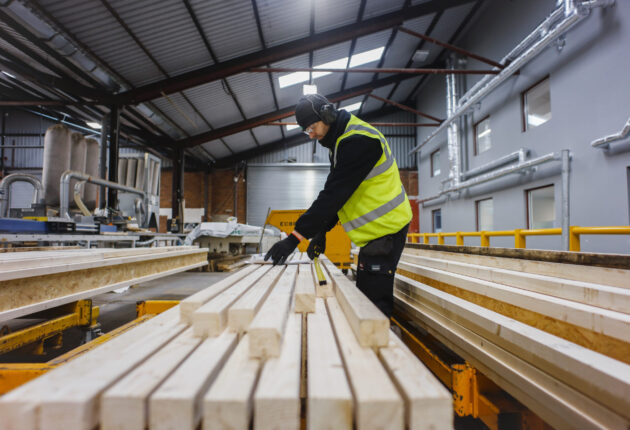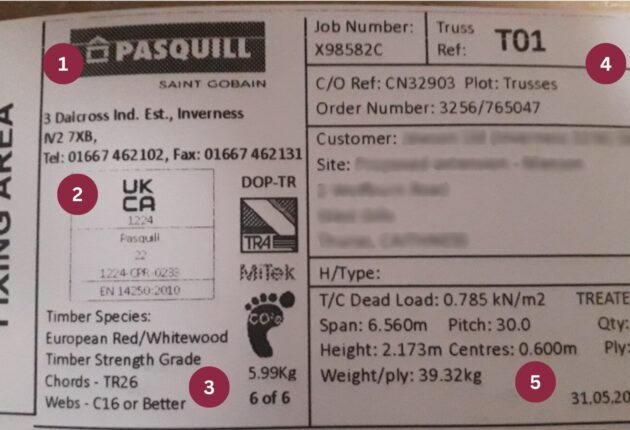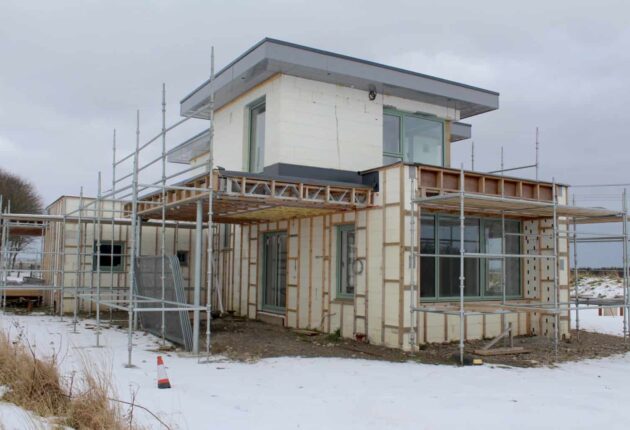A Practical Construction Glossary
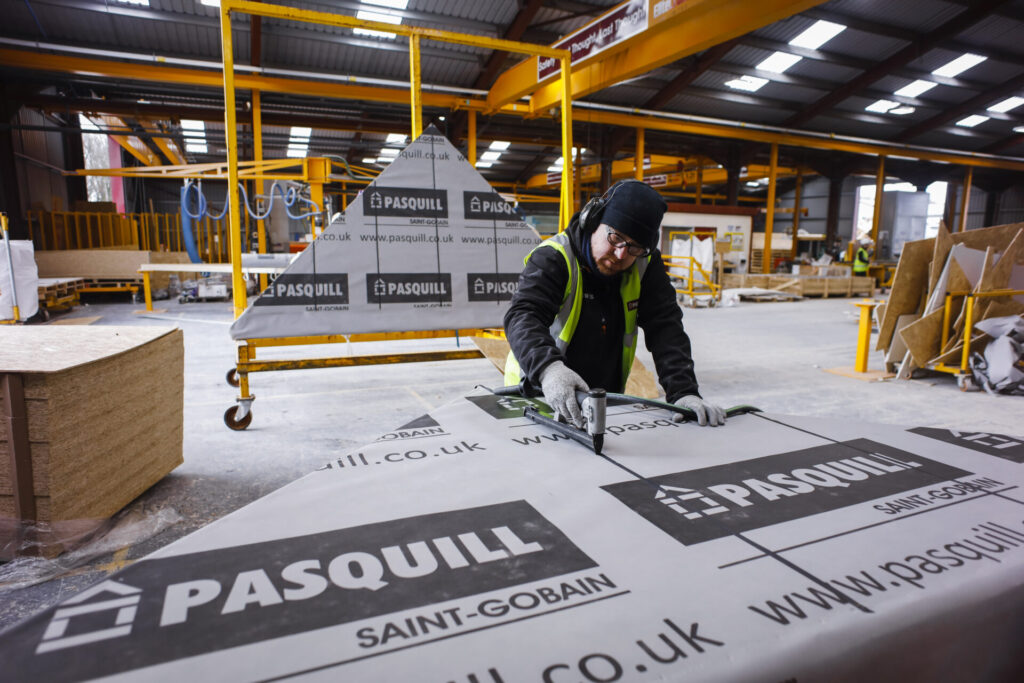
Whether you’re a seasoned professional or a newcomer to the industry, keeping on top of the terminology of the construction industry is crucial.
In this blog, we’ve compiled a comprehensive glossary of construction terms associated with our business. Here it is.
Apex/Peak/Ridge
The highest point of a truss.
Asymmetric Truss
A truss with different pitches on both sides.
Attic truss/room-in-the-roof
An attic truss forms the top storey of a dwelling, creating habitable space by omitting internal web members, compensating with larger timber sizes elsewhere.
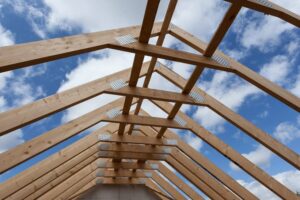
Bargeboard
A board used to conceal roof timbers at the gable end.
Battens
Small timber member that spans trusses to support tiles, slates, and other roofing materials.
Bearer
A member designed to distribute loads over multiple trusses.
Bearing
The part of a truss that receives structural support, typically a wallplate but can also be an internal wall.
Binder
A longitudinal member attached to trusses to maintain correct spacing and prevent movement.
Birdsmouth
A notch in the underside of a rafter that allows for a horizontal seating at the point of support, often used with raised tie trusses.
Blocking
Short timbers fixed between chords to laterally restrain them, typically at least 70% of the depth of the chords.
Bottom chord/Ceiling Tie
The lowest horizontal member of a truss that supports the ceiling construction, storage loads, and water tank.
Bracing
This can be Temporary, Stability, or Wind Bracing, which are described under these headings.
Building Designer
The individual responsible for the overall structural stability and integrity of the building
Cantilever
The part of a structural member of a truss that extends beyond its bearing point.
Chevron Bracing
Diagonal bracing nailed to the truss in the plane of the specified webs to add stability.
Chords
Refers to the top and bottom chords, which are respectively the rafter and ceiling tie of a truss.
Dead Load
The load produced by the permanent structure of the building.
Deflection
The deformation in a truss caused by external loads.
Design Loads
The specific loads for which a truss is designed, considering their duration, such as long-term, medium-term, short-term, and very short-term.
Duo/dual pitch truss
A truss with two rafters meeting at the apex but not necessarily with the same pitch on both sides.
Eaves
The point where the rafter meets the wall.
Extended Rafter
A truss supported at a point on the rafter beyond where it meets the ceiling tie.
Fascia
A horizontal board that runs along the length of the building to cover the truss overhangs.
Fink Truss
The most common type of truss used in dwellings, featuring a duo-pitch design with webs forming a letter W.
Gable End
The end wall that is parallel to the trusses and extends vertically to the rafters.
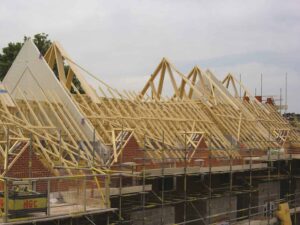
Girder/Beam
A truss or beam designed to carry a higher load than other trusses in the same construction.
Hip End
An alternative to a GABLE END, where the end wall finishes at the same height as the adjacent walls, with the roof inclining from the end wall, usually at the same pitch as the main trusses.
Hip Set
The trusses, girders, and loose timbers needed to form a hip end.
Horn/nib
An extension of the ceiling tie of a truss, typically used in monos or bobtailed trusses.
Imposed Load
The load produced by occupancy and use, including storage, inhabitants, moveable partitions, and snow, but not wind.
Internal Member
Timber members that connect the rafters and the ceiling tie together forming triangular patterns which transmit the forces between them.
Intersection
The point where different roof sections meet.
Jack Rafter
An infill rafter used to complete the roof surface in areas like the corners of HIP ENDS or around chimneys.
Live Load
A term sometimes used for IMPOSED LOADS.
Longitudinal Bracing
A component of STABILITY BRACING.
Loose Timber
Timbers that are not part of a truss but are added to construct the roof in areas where trusses cannot be used.
Mono-pitch truss
A truss in the form of a right-angled triangle with a single rafter.
Node
A point on a truss where its members intersect.
Nailplate
A metal plate with teeth punched in it used to hold the timber joints together.
Noggins
Timber pieces fitted at right angles between rafters and ceiling ties to create fixing points.
Overhang
The extension of a rafter or ceiling tie beyond its support or bearing point.
Part Profile
A truss type formed by truncating a normal triangular truss.
Pitch
The angle of the rafter in relation to the horizontal, typically measured in degrees.
Purlins
Timber members that span over trusses to support cladding or between trusses to support loose timbers.
Queen Post
An internal member (WEB) that connects the APEX to a third point on a FINK TRUSS.
Rafter/Top chord
The uppermost member of a truss that typically carries the roof covering.
Rafter Diagonal Bracing
A component of STABILITY BRACING.
Raised Tie Truss
A truss supported at a point on the rafter beyond where it meets the ceiling tie.
Return Span
The span of a truss being supported by a girder.
Ridge
The line formed by the apexes of the trusses.
Roof Designer
The person responsible for the structural integrity and stability of the entire roof structure.
Scab
Additional timber added to the side of a truss to reinforce it, particularly in RAISED TIE TRUSSES
Setting out Point
The point on a truss where the undersides of the rafter and ceiling tie meet.
Soffit
A board fixed underneath the EAVES overhang to conceal the timbers.
Span
The distance between the outside edges of the two supporting wallplates.
Spandrel Panel
A triangular panel in a timber frame that forms the gable wall above the ceiling line.
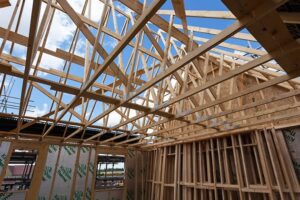
Splice
A joint between two members, using a NAILPLATE
Strap
A metal component designed to fix trusses and wallplates to walls.
Strut
An internal member connecting the third point and the quarter point on a FINK TRUSS.
Stub End
See PART PROFILE.
Temporary Bracing
An arrangement of diagonal loose timbers installed temporarily for safety during construction, often combined with permanent STABILITY and WIND BRACING structures.
Timber Stress Grading
The classification of timber into different structural qualities based on strength.
Trimmer
A piece of timber used to frame around openings.
Truss/Trusses Rafter
A lightweight framework, typically triangulated, used at intervals to support the roof. It is constructed from timber members fastened together with steel nailplates.
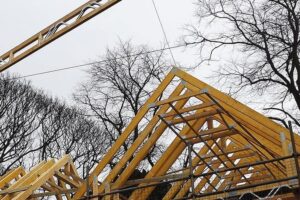
Trussed Rafter Designer
The person responsible for designing the trussed rafter as a component and specifying bracing points.
Truss clip
A metal component designed to provide a secure structural connection between trusses and wallplates, resist wind uplift, and prevent damage caused by skew nailing.
Truss Shoe
A metal component designed to provide a structural connection and support for a truss to a girder or beam.
Uniformly distributed load (UDL)
A load that is evenly spread over the full length of a member.
Valley Board
A member running from the incoming RIDGE to the corner in a valley construction.
Valley Frames/Set
Infill frames used to continue the roofline when roofs intersect.
Verge
The point where the trussed
Wallplate
A timber member laid along the length of the load bearing walls to support the trusses.
Webs
Timber members that connect the rafters and the ceiling tie together forming triangular patterns which transmit the forces between them.
Wind bracing
An arrangement of additional timbers or other structural elements in the roof space, specially designed to transmit wind forces to suitable load-bearing walls.


